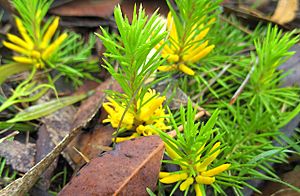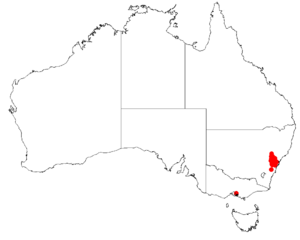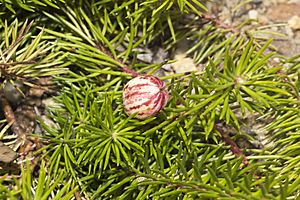Prostrate geebung facts for kids
Quick facts for kids Prostrate geebung |
|
|---|---|
 |
|
| Scientific classification | |
| Genus: |
Persoonia
|
| Species: |
chamaepitys
|
 |
|
| Occurrence data downloaded from AVH | |
| Synonyms | |
|
Linkia chamaepitys (A.Cunn.) Kuntze |
|
Persoonia chamaepitys, commonly known as the prostrate geebung or mountain geebung, is a special type of shrub that only grows in New South Wales, eastern Australia. It grows low to the ground, usually only about 20 cm (8 in) tall, but it can spread out up to 2 m (7 ft) wide. This plant has bright green leaves that look a bit like spines and small yellow flowers that bloom in summer and autumn.
Contents
What Does the Prostrate Geebung Look Like?
The prostrate geebung is a shrub that grows flat on the ground. It usually reaches about 20 cm (8 in) high and can spread out between 1 to 2 m (3 to 7 ft) wide. Its new shoots are covered in tiny hairs.
Leaves and Flowers
The leaves are very small and look like tiny spines. They are about 0.7 to 1.9 cm (0.3 to 0.7 in) long and only 0.5 to 1 mm (0.02 to 0.04 in) wide.
The plant produces small yellow flowers. These flowers appear during spring and summer, usually from October to January. They grow from the ends of the branches or very close to them.
Naming the Prostrate Geebung
The prostrate geebung was first officially described by a botanist named Allan Cunningham in 1825. The exact place where the first sample of this plant was found is not known.
Meaning of the Name
The plant's scientific name, chamaepitys, comes from two Ancient Greek words. "Chamae" means "ground hugging," and "pitys" means "pine." This name was chosen because the plant's leaves look a bit like those of pine trees, and it grows close to the ground.
The prostrate geebung is part of a larger group of plants called Persoonia. It belongs to a specific subgroup of 54 closely related species. These species have similar flowers but very different leaves. They can often breed with each other if they grow in the same area.
Where Does the Prostrate Geebung Live?
The prostrate geebung is only found in central New South Wales. You can see it from the Upper Goulburn Valley, south through the Blue Mountains, and down to the Woronora Plateau and Budawang Range. It is quite common around Katoomba and Mount Victoria.
Habitat and Growing Conditions
This plant grows at heights between 360 to 1100 m (1,180 to 3,610 ft) above sea level. It prefers sandy soils that come from sandstone rocks. You can find it growing in open heathlands or dry sclerophyll forests. In the Blue Mountains, it often grows on slopes or small hills.
Ecology and Life Cycle
The prostrate geebung's flowers attract different types of insects. Long-tongue bees from the Chalicodoma and Hylaeus groups, as well as Eumenid wasps, visit the flowers to find food. However, only one specific type of long-tongue bee, Leioproctus raymenti, helps to pollinate the plant. This means it helps the plant make seeds.
Fruit and Survival
The fruits of the prostrate geebung are eaten by animals like kangaroos, possums, and large birds such as currawongs. When these animals eat the fruit, they help spread the seeds around.
If there is a bushfire, the prostrate geebung plants are usually killed. However, new plants can grow from seeds that have been waiting safely in the soil. This helps the species survive after fires.
Growing Prostrate Geebung in Gardens
Sometimes, people try to grow the prostrate geebung in gardens. However, it can be a bit tricky to grow new plants from either seeds or cuttings.
This plant makes a lovely addition to a rock garden. Its bright green leaves and yellow flowers are very attractive features.



